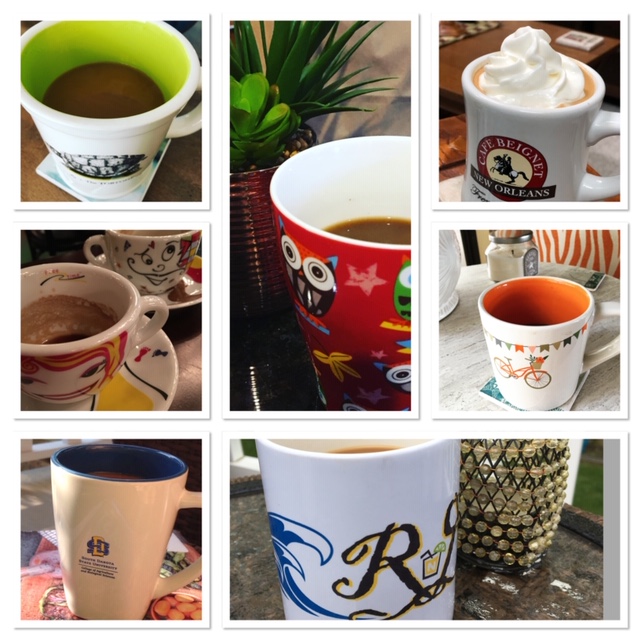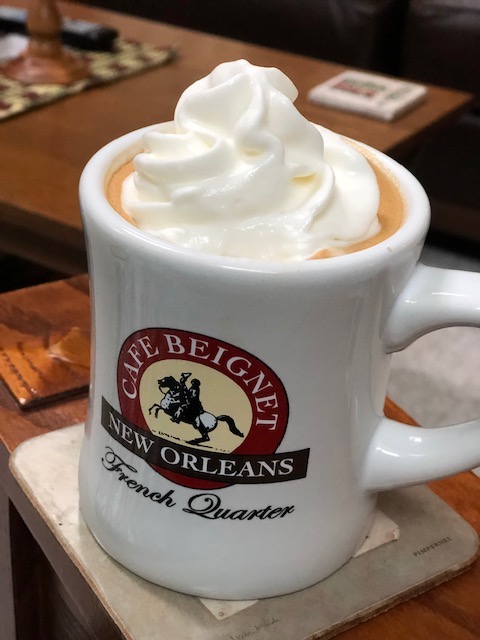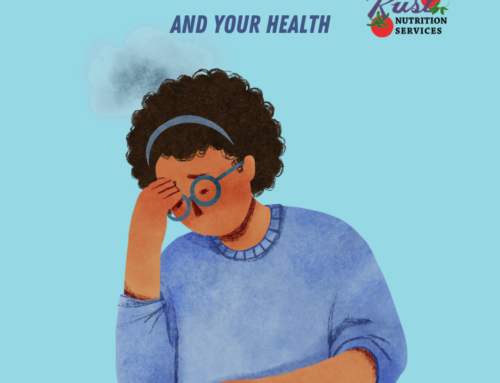You know how everyone gets excited when they read that chocolate is good for them? Well that’s how I feel when I read about coffee.
Are you a regular coffee drinker? I am. I’ve been drinking a daily cup or more since I was a kid. When I was in grade school, my mom used to pour me a cup with lots of milk, and I’d dip my toast in it. Eventually I’d be sipping it, and by the time I was in college I was drinking 2-3 cups a day. I love everything about it. Making it, smelling it brew, and especially drinking that first, hot cup in the morning. I have more than 4 coffee makers. A regular drip pot. A K-cup single cup maker. A Nespresso. An old Italian stove top espresso maker. A French press. Yeah, I love coffee.
Lots of Americans drink coffee every day – about 64%, according to last year’s data from the National Coffee Association. Like many wonderful things, it was accidentally discovered.

Some of my many mugs.
Good news: Coffee may indeed be good for you.
While the exact mechanisms for the health benefit isn’t completely clear, I give you a green light to enjoy your daily dose of coffee.
It could be the caffeine. German scientists recently showed that they could modify heart health of mice by administering the caffeine equivalent to 4 cups of coffee a day. This study showed that caffeine promoted movement of a regulatory protein into mitochondria (the part of most cells that is responsible for generating energy and other important cellular activity). This suggests moderate amounts of caffeine could be protective to our heart.
Other studies have shown there could be some additional health benefits to drinking coffee too. These benefits were shown in correlational studies but it may reduce breast cancer in postmenopausal women, reduce colon cancer risk, and other risks. I know that I simply enjoy it, as my parents and grandparents did, so it seems prudent to continue enjoying my 3 cups a day.
Here are some tips when choosing your coffee habit:
- Enjoy your daily cup (or cups) but be sure that it’s straight coffee.
- It’s best to drink coffee either black or with a little bit of milk or cream (actually, adding some milk adds calcium, and balances out any calcium loss from the caffeine).
- Brew your own coffee whenever possible, or choose fresh brewed coffee. It’s okay to occasionally indulge in a small (tall) fancy coffee from a coffee shop, but straight up coffee is what may provide a health benefit.
- Straight coffee has no calories, but the added sugars, creams, etc can add tons of calories to your day, so check out the menu board. If you don’t love regular brew, try an iced coffee that’s simply coffee with ice, even with small amount of sweetener (at only about 30 calories, or try a sugar free sweetener).
- Skip the type of coffee found in cappuccino machines at your local convenience store or fast food joint. These really don’t have much of a dose of coffee, and are mostly sugars, saturated fat, and artificial flavors.
- If you don’t like coffee, you don’t have to add it to your diet. There are a lot of ways to improve heart health.

A Nespresso® coffee with a bit of whipped cream on top.
Coffee Dictionary
- Latte: This is made with espresso (usually 2 shots) and steamed or frothed low fat milk in a 4:1 ratio of milk to coffee
- Cappuccino: Similar to a latte, but with less steamed milk (2:1 milk to coffee ratio).
- Americana: This is a typically brewed coffee (as through a drip machine). It’s like taking a shot of espresso and adding hot water to it (so a 6 ounce Americano will have the same caffeine as a one-shot of espresso).
- Mocha: This is a coffee drink with milk and chocolate. It’s usually 2 parts coffee, 1-2 parts chocolate syrup, and one part milk.
- Espresso: This is a preparation method really, not a type of coffee bean. Often it’s fine-ground, and brewed more slowly for intense flavor and caffeine. So the coffee itself may not be more caffeinated but the method of brewing increases potency. “One-shot” is one ounce.





Yep, have 3 to 5 cups a day. Love my coffe